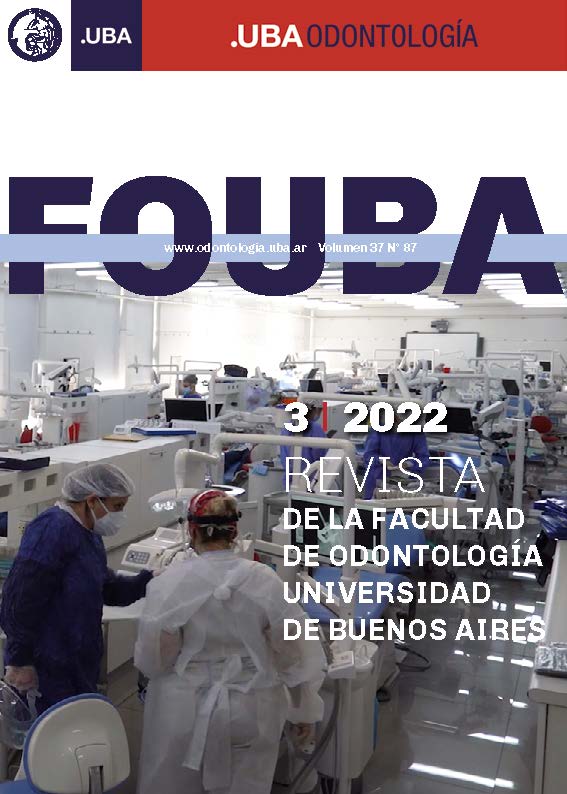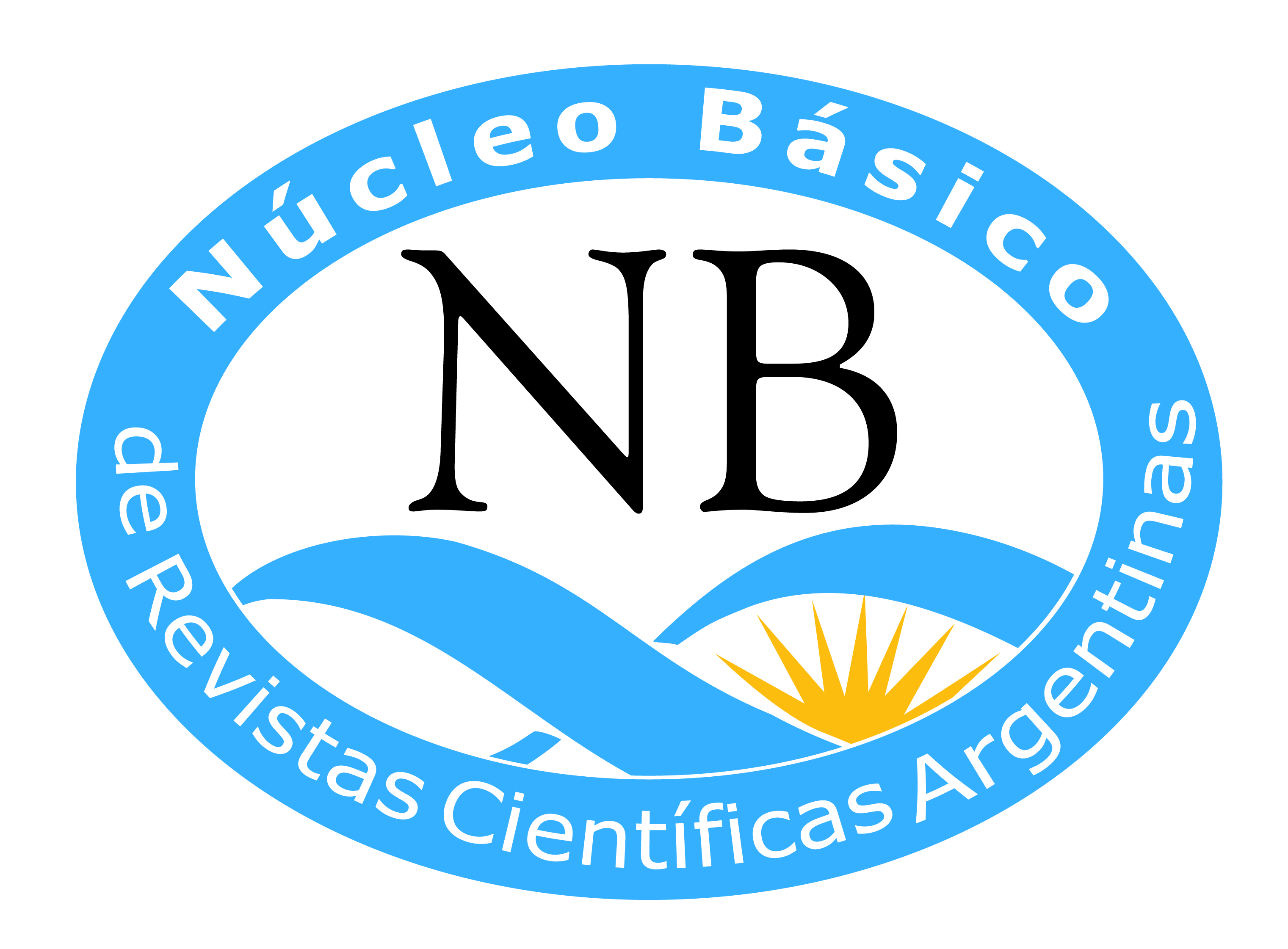Adhesión A Dentina Parte II: Estrategias Para Optimizar la Adhesión a Dentina y Protocolos Adhesivos
Palabras clave:
adhesión a dentina, sellado dentinario inmediato, degradación adhesiva, barro dentinario, protocolos adhesivosResumen
La adhesión a dentina con sistemas adhesivos poliméricos representa todavía un desafío que surge de la necesidad de vincular un sustrato dentario heterogéneo y variable con materiales que presentan todavía ciertos aspectos a atender para poder conseguir el máximo desempeño. El propósito del presente artículo es evaluar algunas de las estrategias propuestas para mejorar la adhesión a dentina y sugerir un protocolo de trabajo con los diferentes tipos de sistemas adhesivos.
Citas
Al Sunbul, H., Silikas, N. y Watts, D. C. (2016). Polymerization shrinkage kinetics and shrinkage-stress in dental resin-composites. Dental Materials, 32(8), 998–1006. https://doi.org/10.1016/j.dental.2016.05.006
Alleman, D. S., Alleman, D. S., Deliperi, S., Aravena Díaz, J., Martins, L. y Keulemans F. (2021). Decoupling with time. Inside Dentistry, 17(8), 35–41. https://id.cdeworld.com/courses/5303-decoupling-with-time
Alleman, D. S., Nejad, M. A. y Alleman, D. S. (2017). The protocols of biomimetic restorative dentistry: 2002 to 2017. Inside Dentistry, 13(6), 64–73. https://www.aegisdentalnetwork.com/id/2017/06/the-protocols-of-biomimetic-restorative-dentistry-2002-to-2017
Awad, M. M., Alrahlah, A., Matinlinna, J. P. y Hamama H. H. (2019). Effect of adhesive air-drying time on bond strength to dentin: a systematic review and meta-analysis. International Journal of Adhesion and Adhesives, 90(2019), 154–162. https://doi.org/10.1016/j.ijadhadh.2019.02.006
Belli, S., Dönmez, N. y Eskitaşcioğlu, G. (2006). The effect of c-factor and flowable resin or fiber use at the interface on microtensile bond strength to dentin. The Journal of Adhesive Dentistry, 8(4), 247–253. https://doi.org/10.3290/j.jad.a11377
Breschi, L., Maravic, T., Cunha, S. R., Comba, A., Cadenaro, M., Tjäderhane, L., Pashley, D. H., Tay, F. R. y Mazzoni, A. (2018). Dentin bonding systems: from dentin collagen structure to bond preservation and clinical applications. Dental Materials, 34(1), 78–96. https://doi.org/10.1016/j.dental.2017.11.005
Cadenaro, M., Breschi, L., Rueggeberg, F. A., Suchko, M., Grodin, E., Agee, K., Di Lenarda, R., Tay, F. R. y Pashley, D. H. (2009). Effects of residual ethanol on the rate and degree of conversion of five experimental resins. Dental Materials, 25(5), 621–628. https://doi.org/10.1016/j.dental.2008.11.005
Cadenaro, M., Maravic, T., Comba, A., Mazzoni, A., Fanfoni, L., Hilton, T., Ferracane, J., y Breschi, L. (2019). The role of polymerization in adhesive dentistry. Dental Materials, 35(1), e1–e22. https://doi.org/10.1016/j.dental.2018.11.012
Carrilho, M. R., Geraldeli, S., Tay, F., de Goes, M. F., Carvalho, R. M., Tjäderhane, L., Reis, A. F., Hebling, J., Mazzoni, A., Breschi, L. y Pashley, D. (2007). In vivo preservation of the hybrid layer by chlorhexidine. Journal of Dental Research, 86(6), 529–533. https://doi.org/10.1177/154405910708600608
Carvalho, R. M., Manso, A. P. y Toledano Pérez, M. (2010). Durabilidad de la unión resina-diente. Una dimensión olvidada. En Henostroza Haro, G (ed.) Adhesión en odontología restauradora. (2da ed). (pp. 575–595). Ripano.
De Rose, L., Krejci, I. y Bortolotto, T. (2015). Immediate endodontic access cavity sealing: fundamentals of a new restorative technique. Odontology, 103(3), 280–285. https://doi.org/10.1007/s10266-014-0174-1
Dietschi, D., Monasevic, M., Krejci, I. y Davidson, C. (2002). Marginal and internal adaptation of class II restorations after immediate or delayed composite placement. Journal of Dentistry, 30(5-6), 259–269. https://doi.org/10.1016/s0300-5712(02)00041-6
Ermis, R. B., Ugurlu, M., Ahmed, M. H. y Van Meerbeek, B. (2019). Universal adhesives benefit from an extra hydrophobic adhesive layer when light cured beforehand. The Journal of Adhesive Dentistry, 21(2), 179–188. https://doi.org/10.3290/j.jad.a42344
Feilzer, A. J., De Gee, A. J. y Davidson, C. L. (1987). Setting stress in composite resin in relation to configuration of the restoration. Journal of Dental Research, 66(11), 1636–1639. https://doi.org/10.1177/00220345870660110601
Hardan, L., Devoto, W., Bourgi, R., Cuevas-Suárez, C. E., Lukomska-Szymanska, M., Fernández-Barrera, M. Á., Cornejo-Ríos, E., Monteiro, P., Zarow, M., Jakubowicz, N., Mancino, D., Haikel, Y. y Kharouf, N. (2022). Immediate dentin sealing for adhesive cementation of indirect restorations: a systematic review and meta-analysis. Gels (Basel, Switzerland), 8(3), 175. https://doi.org/10.3390/gels8030175
Josic, U., Sebold, M., Lins, R. B. E., Savovic, J., Mazzitelli, C., Maravic, T., Mazzoni, A. y Breschi, L. (2022). Does immediate dentin sealing influence postoperative sensitivity in teeth restored with indirect restorations? A systematic review and meta-analysis. Journal of Esthetic and Restorative Dentistry, 34(1), 55–64. https://doi.org/10.1111/jerd.12841
Lu, H., Stansbury, J. W. y Bowman, C. N. (2004). Towards the elucidation of shrinkage stress development and relaxation in dental composites. Dental Materials, 20(10), 979–986. https://doi.org/10.1016/j.dental.2004.05.002
Luque-Martinez, I. V., Perdigão, J., Muñoz, M. A., Sezinando, A., Reis, A. y Loguercio, A. D. (2014). Effects of solvent evaporation time on immediate adhesive properties of universal adhesives to dentin. Dental Materials, 30(10), 1126–1135. https://doi.org/10.1016/j.dental.2014.07.002
Magne P. (2005). Immediate dentin sealing: a fundamental procedure for indirect bonded restorations. Journal of Esthetic and Restorative Dentistry, 17(3), 144–155. https://doi.org/10.1111/j.1708-8240.2005.tb00103.x
Magne P. (2014). IDS: Immediate Dentin Sealing (IDS) for tooth preparations. The Journal of Adhesive Dentistry, 16(6), 594. https://doi.org/10.3290/j.jad.a33324
Mine, A., De Munck, J., Cardoso, M. V., Van Landuyt, K. L., Poitevin, A., Van Ende, A., Matsumoto, M., Yoshida, Y., Kuboki, T., Yatani, H. y Van Meerbeek, B. (2014). Dentin-smear remains at self-etch adhesive interface. Dental Materials, 30(10), 1147–1153. https://doi.org/10.1016/j.dental.2014.07.006
Nikolaenko, S. A., Lohbauer, U., Roggendorf, M., Petschelt, A., Dasch, W. y Frankenberger, R. (2004). Influence of c-factor and layering technique on microtensile bond strength to dentin. Dental Materials, 20(6), 579–585. https://doi.org/10.1016/j.dental.2003.08.001
Pashley, D. H., Tay, F. R., Yiu, C., Hashimoto, M., Breschi, L., Carvalho, R. M. y Ito, S. (2004). Collagen degradation by host-derived enzymes during aging. Journal of Dental Research, 83(3), 216–221. https://doi.org/10.1177/154405910408300306
Price, R. B., Ferracane, J. L., Hickel, R. y Sullivan, B. (2020). The light-curing unit: an essential piece of dental equipment. International Dental Journal, 70(6), 407–417. https://doi.org/10.1111/idj.12582
Rueggeberg, F. A., Giannini, M., Arrais, C. A. G. y Price, R. B. T. (2017). Light curing in dentistry and clinical implications: a literature review. Brazilian Oral Research, 31(suppl 1), e61. https://doi.org/10.1590/1807-3107BOR-2017.vol31.0061
Saikaew, P., Sattabanasuk, V., Harnirattisai, C., Chowdhury, A. F. M. A., Carvalho, R. y Sano, H. (2022). Role of the smear layer in adhesive dentistry and the clinical applications to improve bonding performance. The Japanese Dental Science Review, 58, 59–66. https://doi.org/10.1016/j.jdsr.2021.12.001
Sano, H., Takatsu, T., Ciucchi, B., Horner, J. A., Matthews, W. G. y Pashley, D. H. (1995). Nanoleakage: leakage within the hybrid layer. Operative Dentistry, 20(1), 18–25. https://doi.org/10.2341/1559-2863-20-1-1
Suh, B. I., Feng, L., Pashley, D. H. y Tay, F. R. (2003). Factors contributing to the incompatibility between simplified-step adhesives and chemically-cured or dual-cured composites. Part III. Effect of acidic resin monomers. The Journal of Adhesive Dentistry, 5(4), 267–282.
Tay, F. R. y Pashley, D. H. (2003). Have dentin adhesives become too hydrophilic?. Journal of the Canadian Dental Association, 69(11), 726–731. http://www.cda-adc.ca/jcda/vol-69/issue-11/726.html
Thanatvarakorn, O., Prasansuttiporn, T., Takahashi, M., Thittaweerat, S., Foxton, R. M., Ichinose, S., Tagami, J. y Nakajima, M. (2016). Effect of Scrubbing Technique with Mild Self-etching Adhesives on Dentin Bond Strengths and Nanoleakage Expression. The Journal of Adhesive Dentistry, 18(3), 197–204. https://doi.org/10.3290/j.jad.a36033
Tjäderhane, L., Nascimento, F. D., Breschi, L., Mazzoni, A., Tersariol, I. L., Geraldeli, S., Tezvergil-Mutluay, A., Carrilho, M. R., Carvalho, R. M., Tay, F. R. y Pashley, D. H. (2013). Optimizing dentin bond durability: control of collagen degradation by matrix metalloproteinases and cysteine cathepsins. Dental Materials, 29(1), 116–135. https://doi.org/10.1016/j.dental.2012.08.004
Toledano, M., Osorio, R., Moreira, M. A., Cabrerizo-Vilchez, M. A., Gea, P., Tay, F. R. y Pashley, D. H. (2004). Effect of the hydration status of the smear layer on the wettability and bond strength of a self-etching primer to dentin. American Journal of Dentistry, 17(5), 310–314.
Van Meerbeek, B., Yoshihara, K., Van Landuyt, K., Yoshida, Y. y Peumans, M. (2020). From Buonocore's pioneering acid-etch technique to self-adhering restoratives. A status perspective of rapidly advancing dental adhesive technology. The Journal of Adhesive Dentistry, 22(1), 7–34. https://doi.org/10.3290/j.jad.a43994
Wilson, N. H., Cowan, A. J., Unterbrink, G., Wilson, M. A. y Crisp, R. J. (2000). A clinical evaluation of Class II composites placed using a decoupling technique. The Journal of Adhesive Dentistry, 2(4), 319–329.
Zou, L., Shen, Y., Li, W. y Haapasalo, M. (2010). Penetration of sodium hypochlorite into dentin. Journal of Endodontics, 36(5), 793–796. https://doi.org/10.1016/j.joen.2010.02.005
Publicado
Cómo citar
Número
Sección
Licencia
Derechos de autor 2023 Revista de la Facultad de Odontologia de la Universidad de Buenos Aires

Esta obra está bajo una licencia internacional Creative Commons Atribución-NoComercial-SinDerivadas 4.0.











